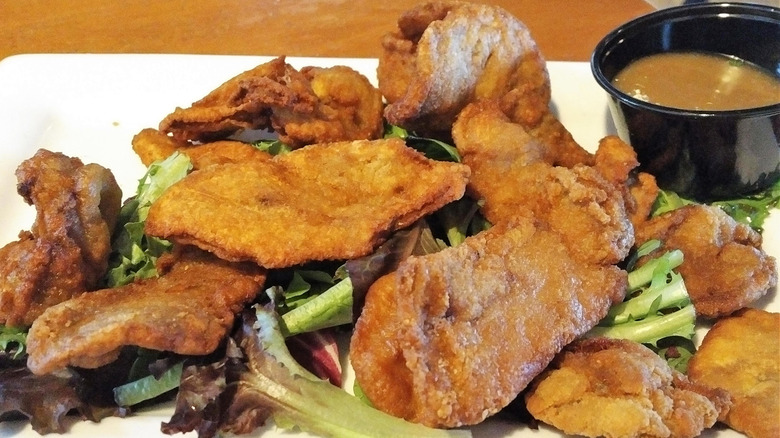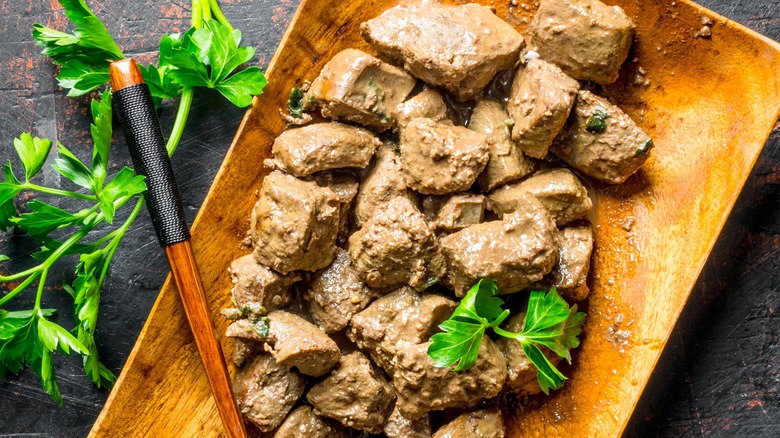What Is A Rocky Mountain Oyster? Hint — It's Not Seafood
Trawling the depths of the ocean and scraping against the seabed, you're unlikely to find Rocky Mountain oysters. Although they sound like a cousin of Wellfleet oysters, the term actually refers to a dish with origins much farther inland. Named for the rugged Colorado range, the lesser-known food is made of fried bull's testicles.
Cowboys, ranchers, and farmers with a surplus of steers enjoy the crispy snack — and they have their fair share of nicknames. They range from the tame "prairie oysters" and "calf fries" to ballsy euphemisms like "swinging beef" and "dusted nuts." And while their name implies they're a high altitude specialty, other states — like Montana and Nevada, as well as countries around the world – prepare the ingredient, too.
Rocky Mountain oysters are also the wrench thrown in cooking competitions like "Chopped" and "Top Chef," stumping chefs unfamiliar with the globes. In addition to their misleading name, the offal can be tricky to prepare. The trick to frying up tender nuggets is peeling off the tough membrane before slicing them into portions and cooking them up.
Eating and enjoying Rocky Mountain oysters
Fans of the cooked reproductive organ highlight its texture and juiciness, describing the taste as mildly gamey or having a hint of iron, like chicken innards. They also take well to strong seasonings and the heavy salt that often accompanies fried food. When prepared just right, the fried strips are tender rather than chewy, similar to properly prepared octopus or squid.
Like briny oysters, the gonads are also viewed as an aphrodisiac by some. Virility boost aside, the food did help fuel workers both out in the field and in meatpacking factories. Historically, they were prepared when ranchers had an abundance of the ingredients after castrating veal and steers. And similar to preparing cowboy coffee, ranchers relied on rustic setups and the heat of a fire to cook the offal during the busy season.
Today's better-known wrangler preparation features a crispy batter and bright dipping sauce to brighten up the tame flavor — although in Mexico, the ingredient gets a saute with other veggies before being served in a hot tortilla; in South America, they're prepared as a ceviche. Although it's possible to track them down by requesting them from a butcher or shopping online, city-dwelling cooks wanting to make them at home may have trouble finding them at the grocery. You're better off conducting a taste test at one of the many testicle festivals dedicated to this delicacy of a dish.
Edible testicles from other animals
The beef product may have earned a reputation and a great name, but diners also dabble in other animal organs. Lamb, duck, goat, and pork testicles have their share of fans. Each species has a slightly different flavor, with duck and pork gaining a reputation for a milder flavor compared to the robust gaminess of sheep.
Enthusiastic eaters enjoy grilling and pan-searing the meats, as well as opting for the classic battered-and-fried approach. Lamb fries, for example, are another popular dish among American farmers — though their name inspires less seafood-related intrigue. In Pakistan, stronger-tasting goat or sheep gonads are prepared alongside other chopped offal in a generously spiced dish called kata kat. Petite duck testicles are known for their milder taste — though the organ takes well to a dose of acid.
As with Rocky Mountain oysters, it may be a challenge to hunt down the proteins, but they're a worthy culinary challenge. However, before digging in, we recommend giving parts from barnyard animals like goat and lamb a milk soak. Just like when you're facing unpleasantly smelly fish or particularly bracing offal, this will help extract and neutralize some of the sharper flavors. Consider imbuing your dish with a bit of char and smoke, as well, to mellow the gamey notes. Then, feel free to have a ball.



